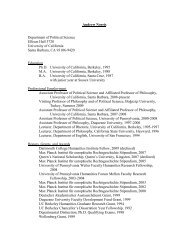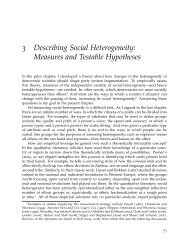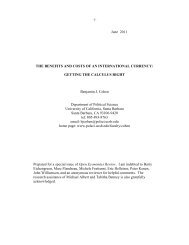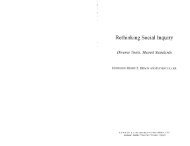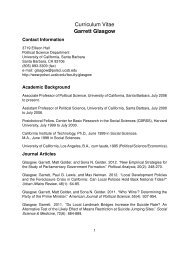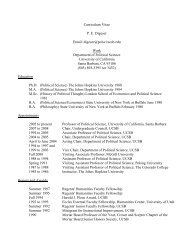-1- May 2012 THE YUAN'S LONG MARCH* Benjamin J. Cohen Can ...
-1- May 2012 THE YUAN'S LONG MARCH* Benjamin J. Cohen Can ...
-1- May 2012 THE YUAN'S LONG MARCH* Benjamin J. Cohen Can ...
You also want an ePaper? Increase the reach of your titles
YUMPU automatically turns print PDFs into web optimized ePapers that Google loves.
-1-<br />
<strong>May</strong> <strong>2012</strong><br />
<strong>THE</strong> YUAN’S <strong>LONG</strong> <strong>MARCH*</strong><br />
<strong>Benjamin</strong> J. <strong>Cohen</strong><br />
<strong>Can</strong> a state manufacture an international currency? After long hesitation, Beijing appears<br />
to have made internationalization of the renminbi (the “people’s currency”) an official policy<br />
goal, and a concerted strategy is now being implemented with that lofty ambition in mind. This<br />
essay seeks to explain what can be learned from China’s internationalization strategy about both<br />
the uses and the limits of power in today’s world economy. First, to set the stage, the nature of<br />
the challenge facing China is briefly explained, followed by an outline of the principal features<br />
of Beijing’s internationalization strategy. In the central sections of the essay I then take up two<br />
critical issues. First is the question of strategic design. This is a matter of China’s intentions.<br />
What are the government’s ultimate objectives, and is the Long March properly conceived to<br />
achieve them? Second, I evaluate Beijing’s choice of means. This is a matter of China’s<br />
statecraft. Have the authorities chosen the right tools and instruments? Are the country’s power<br />
resources sufficient for the task at hand? Analysis suggests that while China’s strategy is<br />
soundly conceived, its chosen means may well prove inadequate owing to a range of practical<br />
limitations. Progress of the RMB as an international currency will not come easily.
-2-<br />
<strong>Can</strong> a state manufacture an international currency? The question is raised by China’s<br />
determined efforts to promote the role of its national money, the yuan or renminbi (RMB), as an<br />
international currency. After long hesitation, Beijing appears to have made internationalization<br />
of the “people’s currency”an official policy goal, and a concerted strategy is now being<br />
implemented with that lofty ambition in mind. The yuan has embarked on a Long March toward<br />
global status, reminiscent of the Long March that was so pivotal in the Communist Party’s<br />
victory in China’s civil war. This is clearly a purposeful act. Power resources are being<br />
employed instrumentally to widen foreign use of the RMB; wider use of the RMB, in turn, is<br />
expected to enhance Chinese prestige and influence. This essay seeks to explain what can be<br />
learned from China’s internationalization strategy about both the uses and the limits of power in<br />
today’s world economy.<br />
The subject of yuan internationalization has drawn a great deal of attention in recent<br />
years. 1 For many, internationalization is the RMB’s manifest destiny – an irresistible by-product<br />
of China’s remarkable economic success. Wide use of the yuan is said to be “inevitable.” 2 The<br />
only question, it seems, is how many years the Long March will take. But is such confidence<br />
warranted? In reality, the challenge that China faces is extraordinarily daunting. Success in<br />
manufacturing an international currency is by no means guaranteed.<br />
This essay is organized as follows. First, to set the stage, the nature of the challenge<br />
facing China is briefly explained, followed by an outline of the principal features of Beijing’s<br />
internationalization strategy. In the central sections of the essay I then take up two critical issues.<br />
First is the question of strategic design. This is a matter of China’s intentions. What are the<br />
government’s ultimate objectives, and is the Long March properly conceived to achieve them?<br />
Second, I evaluate Beijing’s choice of means. This is a matter of China’s statecraft. Have the<br />
authorities chosen the right tools and instruments? Are the country’s power resources sufficient<br />
for the task at hand? Analysis suggests that while China’s strategy is soundly conceived, its<br />
chosen means may well prove inadequate owing to a range of practical limitations. Progress of<br />
the RMB as an international currency will not come easily. In conclusion, lessons for the study of<br />
power in a changing world economy are highlighted.<br />
<strong>THE</strong> CHALLENGE<br />
A flourishing world economy needs some kind of internationally acceptable money.<br />
Otherwise, nations would be reduced to crude barter, severely limiting gains from cross-border<br />
trade or investment. From an efficiency point of view, a single supranational currency would<br />
seem to be most appealing, since transactions costs would be minimized. But in a fragmented<br />
world of nearly two hundred sovereign states, most observers agree, the likelihood of reaching<br />
credible agreement on terms for the creation and management of a genuine global money is<br />
minimal. From a political point of view the option seems unattainable, even risible. Much more<br />
realistic is the prospect that the world will continue in the future, as it has in the past, to rely<br />
mainly on a limited selection of national currencies to play vital international roles.<br />
Manufacturing a national currency, history suggests, is comparatively easy – by no means<br />
a walk in the park, but certainly doable. A national currency, in principle, exercises an exclusive<br />
claim to all the traditional roles of money – medium of exchange, unit of account, store of value –<br />
in a single country. For centuries, dating back to the Peace of Westphalia of 1648, governments<br />
have claimed supreme authority – sovereignty --within the territorial frontiers of their individual
-3-<br />
states. In one corollary of the so-called Westphalian system, evident since at least the nineteenth<br />
century, most governments have self-consciously sought through legal-tender laws and related<br />
regulatory measures to create and sustain a single national currency – effectively, an exclusive<br />
“territorial” currency. Control over money, exercised through the coercive powers of the state,<br />
came to be considered one essential ingredient of sovereignty. The result is a monetary universe<br />
today that consists of a myriad of territorially based national currencies – a structure I have<br />
elsewhere characterized as the Westphalian model of monetary geography, based on the norm of<br />
One Nation/One Money (<strong>Cohen</strong> 1998, 2004).<br />
Manufacturing an international currency, by contrast, is much more difficult – precisely<br />
because of the One Nation/One Money norm. In a world of sovereign states, no government can<br />
easily compel outsiders to use its money, whether for trade purposes or as an investment or<br />
reserve medium. The capacity for direct coercion is limited. Instead, influence must be exercised<br />
indirectly, through other pathways. One pathway might involve bribery in one form or another (a<br />
variant of the first face of power). Another might seek to exploit characteristics of systemic<br />
architecture to favorably alter incentive structures (the second face of power). And yet another<br />
might involve strategies of persuasion, attraction, or co-option intended to work through<br />
constitutive impacts on identities and interests (the third face of power). For a government<br />
determined to promote internationalization of its currency, the means available are many.<br />
Monetary statecraft can be implemented through a variety of instruments, as China’s current<br />
efforts demonstrate. But there is no assurance that any of them may actually turn out to be<br />
successful.<br />
In fact, precedent would not appear to favor the yuan. In modern times, only one country<br />
– Japan in the 1990s – has actively sought to manufacture a wider role for its currency (Grimes<br />
2003, 2009); and that campaign turned out to be largely futile. Of the several currencies that have<br />
achieved international status over the last couple of centuries -- including the pound sterling, US<br />
dollar, and, most recently, the euro – none came into widespread use as the result of official<br />
planning by a formal governmental bureaucracy (Frankel 2011). If a national money attained<br />
international status, it was because of inherent qualities that gradually came to make the currency<br />
attractive to traders, investors, and other interested agents. Internationalization emerged as a<br />
result of an unplanned process of competition among currencies, driven by a spontaneous<br />
evolution of preferences on the demand side of the market. There is no successful prior model for<br />
Beijing’s effort to jump-start the process from the supply side – what one source (McCauley<br />
2011) describes as “managed internationalization.”<br />
The challenge posed for China, therefore, is clear. If internationalization is to be achieved,<br />
the yuan must be able to compete effectively with other widely used currencies. It must be made<br />
more appealing to market actors. The question is: <strong>Can</strong> demand-side preferences be durably<br />
modified by state-led measures on the supply side? That appears to be Beijing’s intent. The goal<br />
is not unreasonable. As the world’s second largest economy and leader in global exports, China<br />
already offers the foundation of a broad transactional network – a significant source of power.<br />
Beijing seems determined to build on that foundation to enhance the yuan’s appeal for various<br />
cross-border purposes. But whether the goal is attainable is another matter entirely.<br />
<strong>THE</strong> STRATEGY
-4-<br />
Though no precise date can be identified when Beijing first leaned toward the goal of<br />
internationalization, a key turning point came in 2006 with publication of a report on “The<br />
Timing, Path, and Strategies of RMB Internationalization” by a study group set up by the<br />
People’s Bank of China (PBOC), China’s central bank (PBOC Study Group 2006). “The time has<br />
come for promotion of the internationalization of the yuan,” the study group argued.<br />
Internationalization “can enhance China’s international status and competitiveness significantly<br />
[and] will increase its influence in the international economy.” China will “have a greater say”<br />
and will enjoy “a rise in power standing.” We “should take advantage of the opportunity,” the<br />
report concluded. Internationalization is “an inevitable choice.”<br />
Many in China’s leadership evidently agreed. Within government and party circles a<br />
distinct shift of attitude soon became apparent, spurred in particular by the financial crisis that<br />
struck the world economy in 2008. With its vast hoard of dollar reserves, Beijing had every<br />
reason to feel vulnerable to a sudden shift of exchange rates. Internationalization of the yuan<br />
might provide a useful means to reduce dependence on America’s greenback.<br />
Elite opinion has by no means been unanimous. In fact, divisions over the issue have been<br />
evident in Beijing for some time. On the one side are factions led by the PBOC, who see<br />
internationalization as a means to push forward with liberal financial reforms. On the other side<br />
are a range of producer interests fearful that wider use of the yuan might drive up its value,<br />
eroding export competitiveness, as well as banks and state-owned enterprises that have long<br />
benefitted from the government’s firm controls over interest rates and credit allocation. Internal<br />
cleavages are probably the reason why, to this day, there has never been a formal declaration<br />
pronouncing internationalization official Chinese policy. Judging from Beijing’s actions,<br />
however, it seems quite clear which way the prevailing wind is blowing. By late 2009, as one<br />
observer has put it, “The Chinese Government obviously changed its mind and became<br />
enthusiastic about RMB internationalization” (Zhang 2009: 24). By 2011, internationalization<br />
had assumed a place “at the heart of China’s financial strategy,” according to an influential<br />
advisor to the PBOC. 3<br />
But how was the goal to be achieved? Up to the time of the PBOC’s Study Group report,<br />
China had one of the most tightly controlled currencies in the world, hemmed in by all manner of<br />
exchange restrictions and capital controls. How could cross-border use of the RMB be promoted<br />
if the money was not easily convertible? Moreover, the country’s leadership knew that there was<br />
no successful model in recent history for manufacturing an international currency. They had no<br />
road map to help guide their actions. Not surprisingly, therefore, the government’s approach has<br />
been noticeably cautious, a careful choreography stressing gradualism above all. Following Deng<br />
Xiaoping’s dictum to “cross the river by feeling the stones,” strategy has developed incrementally<br />
in multiple small steps. China’s ruling Communist Party is no stranger to the idea of a Long<br />
March.<br />
Effectively, managed internationalization has been pursued along two interrelated tracks<br />
(Subacchi 2010). One track focuses on cultivating use of the RMB in foreign trade. At the<br />
official level, currency swap agreements with foreign central banks have been initiated facilitating<br />
use of the RMB as a means of payment. At the private level, regulations have been gradually<br />
eased to permit more trade transactions to be invoiced and settled in yuan, bypassing traditional<br />
invoicing currencies like the dollar. The other track focuses on use of the RMB in international
-5-<br />
finance. Emphasis has been placed on the development of active markets for yuan deposits and<br />
yuan-denominated bonds, mainly “offshore” in the autonomous region of Hong Kong. Along<br />
both tracks, initiatives have been implemented patiently in finely calibrated phases.<br />
Trade track<br />
On the first track the yuan’s Long March began in late 2008, when the PBOC set out to<br />
negotiate a series of local currency swap agreements designed to provide RMB funding to other<br />
central banks, when needed, for use in trade with China. In little over three years pacts had been<br />
signed with 18 countries 4 comprising a total value of nearly 1540 billion yuan (roughly $245<br />
billion). Ostensibly, the aim of these agreements was to insure against the kind of risks that could<br />
come with another global financial crisis. The availability of RMB funding on an emergency<br />
basis would offer China’s trading partners a useful hedge against any future liquidity crunch. But<br />
the facilities were also designed to supply yuan, when desired, for use in bilateral trade on a more<br />
regular basis – in effect, to provide indirect encouragement for commercial use of the Chinese<br />
currency. None, however, has as yet been used for that purpose. For the time being China’s<br />
trading partners still prefer to use the more widely accepted greenback as a settlement currency.<br />
More directly, beginning in 2009, Beijing has gradually widened the range of trade<br />
transactions that may be settled in yuan, further promoting the currency’s use by non-residents.<br />
Informally, the RMB has long been accepted as a settlement currency in border trade with<br />
neighboring countries such as Laos, Mongolia, Myanmar, Nepal, North Korea, and Vietnam,<br />
resulting in a substantial growth in the volume of yuan bank notes circulating beyond China’s<br />
borders. Although overall estimates vary widely and are of questionable reliability, it is clear that<br />
the numbers are no longer trivial. According to one source (Yu and Gao 2011: 198), as much as<br />
60 percent of cash in circulation in Mongolia may now be RMB. Formal authorization of yuan<br />
trade settlement, which began with a limited pilot scheme in 2009, was extended to all Chinese<br />
enterprises by early <strong>2012</strong>. Additionally, since September 2010, foreign enterprises have been<br />
authorized to open cross-border yuan settlement accounts at locally registered banks in China,<br />
further expanding opportunities for use of the RMB on a regular basis. And along the way the<br />
PBOC has been busily constructing a new China International Payment System, a vital piece of<br />
technical infrastructure to facilitate cross-border invoicing and payments. By mid-2011 as much<br />
as eight percent of Chinese trade was being settled in yuan, up from essentially zero in previous<br />
years.<br />
Finance track<br />
On the second track Beijing has relied heavily on the special status of the autonomous<br />
region of Hong Kong, which offers a useful offshore laboratory for experimenting with<br />
innovations that the leadership is not yet prepared to introduce “onshore”on the Mainland. As<br />
frequently noted (Frankel 2011), this is, to say the least, an unusual pattern. Never before has any<br />
government sought deliberately to develop an offshore market for its currency while still<br />
maintaining strict financial control at home. In effect, Beijing is drawing up its own road map,<br />
relying heavily on the Hong Kong Monetary Authority (HKMA) – de facto, Hong Kong’s central
-6-<br />
bank and chief financial regulator – to act as its proxy.<br />
As early as 2004 the HKMA launched the RMB Business Scheme, allowing banks in<br />
Hong Kong to open yuan deposit accounts for individuals and some enterprises. But the offshore<br />
deposit market, informally known as the CNH market, 5 did not really begin to take off until mid-<br />
2010, when new rules were issued relaxing restrictions on the yuan activities of Hong Kong<br />
banks. Daily trading of the RMB on the Hong Kong foreign-exchange market was now<br />
permitted, and local financial institutions for the first time were allowed to open yuan accounts of<br />
their own, clearing the way for creation of a wider range of marketable financial products. The<br />
result was a swift growth in the total value of CNH deposits, from less than 65 billion yuan ($10<br />
billion) at the end of 2009 to as much as 627 billion yuan ($100 billion) in November 2011,<br />
before dropping back below 570 billion yuan in early <strong>2012</strong>.<br />
Development of an offshore market for yuan-denominated bonds began in mid-2007,<br />
when selected Mainland banks were permitted for the first time to raise funds by issuing RMB<br />
bonds in Hong Kong. Progress in the so-called “Dim Sum” bond market, however, was slow<br />
until 2010, when permission was extended first to Chinese non-financial firms and then to foreign<br />
multinationals doing business in China. Among the first non-Chinese companies to enter, in June<br />
2010, were Hong Kong and Shanghai Banking Corporation (HSBC) and the Bank of East Asia,<br />
followed later by such big names as McDonald’s, Caterpillar, Volkswagen, and Unilever. In<br />
2011 new issues topped 174 billion yuan ($27.6 billion), up from 40 billion yuan ($6.3 billion) in<br />
2010 and a cumulative total of just 22 billion yuan ($3.3 billion) previously – a not insignificant<br />
rate of increase, but still minuscule amounts by international standards.<br />
Finally, parallel to the Dim Sum market, a nascent onshore market for yuan-denominated<br />
bonds, centered in Shanghai, has been cautiously cultivated since 2005, when debt sales by non-<br />
Chinese issuers – known as “Panda” bonds -- were authorized inside China for the first time.<br />
Progress here, however, has been extremely sluggish, even after a well publicized pledge by<br />
China’s State Council in 2009 to transform Shanghai into an international financial center by no<br />
later than 2020. Initially limited just to “eligible” multilateral development institutions, access to<br />
the Panda bond market was broadened in 2009 to include locally incorporated subsidiaries of<br />
foreign multinationals. But as of the start of 2011, there had still only been five issues in all – two<br />
each by the Asian Development Bank and the International Finance Corporation, a branch of the<br />
World Bank, and one by Tokyo-Mitsubishi UFJ (China) Ltd, for a total of just 5 billion yuan<br />
($795 million).<br />
STRATEGIC DESIGN<br />
Overall, there seems little doubt that internationalization has indeed assumed a place at the<br />
heart of China’s financial strategy. But an international currency, clearly, is not an end in itself.<br />
Rather, the yuan’s Long March must be seen as a means to promote more fundamental interests<br />
and aspirations. That raises the question of strategic design. What are Beijing’s ultimate goals,<br />
and is the government’s strategy properly conceived to achieve them?<br />
The question of design matters because internationalization is by no means a journey with<br />
a single unique destination. Currency internationalization involves multiple roles; the net benefits<br />
of individual roles may vary quite considerably; and different currencies may embody diverse
-7-<br />
mixtures of roles. To design an internationalization strategy properly, a country’s leaders must<br />
first know what their priorities are; and then, second, be sure to focus their attention on the<br />
combination of roles that is most likely to satisfy their ambitions. The task, needless to say, is<br />
easier said than done.<br />
Roles and benefits<br />
That currency internationalization involves a multiplicity of roles is widely recognized.<br />
There is, in fact, a standard taxonomy for characterizing the roles of international money, which<br />
separates out the three familiar functions of money – medium of exchange, unit of account, store<br />
of value – at two levels of analysis: the private market and official policy, adding up to six roles<br />
in all. 6 Sources generally speak of the separate roles of an international currency at the private<br />
level in foreign-exchange trading (medium of exchange), trade invoicing and settlement (unit of<br />
account and medium of exchange), and financial markets (store of value). At the official level,<br />
we speak of a money’s roles as an exchange-rate anchor (unit of account), intervention currency<br />
(medium of exchange), or reserve currency (store of value). Though to some extent<br />
interdependent, each of the six roles is understood to be distinct in practical as well as analytical<br />
terms.<br />
It is also widely recognized that internationalization can also yield significant benefits for<br />
an issuing country. In a diverse scholarly literature stretching back decades, drawing from<br />
political science as well as economics, a total of some five broad classes of gains can be identified<br />
(<strong>Cohen</strong> <strong>2012</strong>a). Briefly, these include:<br />
1. Reduced transactions costs. At the microeconomic level, residents of the issuing<br />
country benefit from their ability to do business abroad in home currency, thus lowering exchange<br />
risk. In addition, profits in the financial sector may be increased as foreign business can be<br />
expanded at lower cost.<br />
2. Seigniorage. At the macroeconomic level, benefits are generated whenever foreigners<br />
acquire some amount of domestic money in exchange for traded goods and services. Crossborder<br />
accumulations represent an implicit economic transfer that constitutes a real-resource gain<br />
for the economy as a whole.<br />
3. Macroeconomic flexibility. Cross-border use of a currency can also loosen the<br />
constraint of the balance of payments on monetary and fiscal policy. The greater is the ability to<br />
finance external deficits with the country’s own money, delaying or deflecting adjustment costs,<br />
the easier it is for the government to pursue policy objectives at home or abroad. In effect, the<br />
autonomy dimension of power is enhanced. The benefit is typically thought of mainly in terms of<br />
economic advantage: the issuer has more latitude to manage domestic employment levels or price<br />
behavior. But there is also an obvious political aspect insofar as relaxation of the external<br />
payments constraint augments the issuer’s ability to promote foreign diplomatic or military<br />
interests as well.<br />
4. Leverage. Influence, a form of “hard” power, is a fourth possible benefit of an<br />
international currency. The autonomy that derives from macroeconomic flexibility, I have argued<br />
elsewhere (<strong>Cohen</strong> 2006), is vital to creating a capacity for leverage over others. Whether that<br />
capacity can be actualized, however, is uncertain and rests on additional considerations. Key is
-8-<br />
the degree of dependence that is engendered as foreigners come to rely on the national money for<br />
any of several international roles. The dependence of others puts the issuer in a position to<br />
exercise influence through its control of access to vital financial resources.<br />
5. Reputation. Finally, at the symbolic level, widespread international use of a currency<br />
can promote the issuer’s overall reputation in world affairs – enhancing authority, a form of “soft”<br />
power. Broad circulation may become a source of status and prestige, a visible sign of elevated<br />
rank in the community of nations. Influence may then be exercised through co-option and<br />
attraction to shape the preferences of others. Though difficult to pin down empirically, the<br />
importance of soft power in monetary affairs has by now been well established by historical and<br />
contemporary research (<strong>Cohen</strong> 1998, Helleiner 2003).<br />
Not all of these five classes of gains, however, can be associated with every role of an<br />
international currency. To the contrary, it seems more reasonable to assume that the net effects of<br />
the separate roles might actually differ quite substantially, as I have suggested elsewhere (<strong>Cohen</strong><br />
2010, <strong>2012</strong>a). Perhaps the most critical difference is between the several medium-of-exchange<br />
and unit-of-account roles, on the one hand, and the two store-of-value roles on the other. Use of a<br />
currency in foreign-exchange trading, trade invoicing, or for official intervention purposes will<br />
almost certainly generate some measure of gain at the microeconomic level. But only the storeof-value<br />
roles, which by definition imply some level of foreign accumulations, will generate any<br />
amount of seigniorage or macroeconomic flexibility for the issuing country – gains that could be<br />
quite substantial in magnitude. Neither seigniorage nor greater policy flexibility is possible<br />
unless non-residents are willing and able to acquire significant amounts of the country’s currency,<br />
or assets denominated in the currency, as a store of value. This suggests that the benefits of<br />
internationalization are unlikely to loom large if external use is limited alone to trade invoicing or<br />
the exchange market, which require minimal working balances at most. A considerable role in<br />
financial markets and/or reserves will be needed to make internationalization really pay<br />
economically or politically.<br />
Priorities and focus<br />
Seen in this light, Beijing’s strategic design would appear to be reasonably well<br />
conceived. Attention seems to be focused properly on the combination of roles that is most likely<br />
to satisfy the government’s ambitions. The Hong Kong and Shanghai Banking Corporation<br />
(HSBC 2011: 15) summarizes succinctly: “First trade, then investment; and after that, reserve<br />
currency status. That is the road map for the renminbi in a single sentence.”<br />
Of course, no one outside the ranks of China’s secretive leadership can be sure what the<br />
government’s priorities really are. Here too there may be divisions behind the scenes. Inferring<br />
from years of policy behavior, however, it seems fair to assume that aspirations must include<br />
political as well as strictly economic considerations. China may have an interest in saving on<br />
transactions costs or garnering a bit of seigniorage. Likewise, it is not unreasonable for the<br />
world’s biggest exporter to seek to use its own money more to reduce the currency mismatch in<br />
its international balance sheet. But from all we know about Beijing’s ambitions for a “peaceful<br />
rise” to great-power status, we have to assume that some measure of power is being sought as<br />
well. At a minimum this would involve a greater degree of autonomy, to reduce a sense of
-9-<br />
vulnerability to external crises or the tribulations of the dollar. Beyond that it is hard to imagine<br />
that China would not also like to attain, ultimately, a greater measure of influence in global<br />
affairs. As one informed source suggests, there may be an “economic China” concentrated on<br />
economic development and modernization. But there is also a “political China” determined,<br />
above all, “to achieve and maintain power in an asymmetric power relation to Western<br />
superpowers.” 7 “Great powers have great currencies,” Robert Mundell, a Nobel laureate in<br />
economics, once declared (1993: 10). Political China would appear to agree.<br />
Assuming that to be the case, Beijing’s strategy seems right on target. In a separate<br />
discussion (<strong>Cohen</strong> 2010), I have explored the relationship between currency internationalization<br />
and state power. My analysis indicates that three of an international money’s six possible roles<br />
are of paramount importance in promoting an issuing country’s power. These are the roles in<br />
financial markets, trade, and central-bank reserves. The roles in financial markets and reserves<br />
enhance the issuer’s monetary autonomy, making it easier to delay or deflect adjustment costs.<br />
Autonomy in turn creates a capacity for influence, though whether that capacity can be actualized<br />
will depend on additional considerations that may vary widely over time. A currency’s role in<br />
trade is important, above all, because of its impact on the reserve preferences of foreign central<br />
banks. The currency composition of central-bank reserves generally tends to reflect the pattern of<br />
currency choice in an economy’s international commercial relationships. The more a money is<br />
used for each of these three roles, the greater is its contribution to the issuer’s power.<br />
It makes sense, therefore, for Beijing to have chosen the two tracks that it has pursued<br />
until now. The finance track is critical to establishing the appeal of the RMB as an investment<br />
medium, starting with bank deposits and bonds and then, presumably, moving on to a steadily<br />
widening range of financial products. Though the financial-market role, on its own, is not apt to<br />
add much to China’s external power, it is an essential first step toward reserve-currency status,<br />
which surely promises a greater measure of influence. A given money can play an investment<br />
role even if never used as a reserve currency. The reverse, however, is unlikely ever to happen in<br />
a market-based currency system. Monetary history suggests that the investment role comes first<br />
and then is followed by a reserve role in addition. Certainly that was the pattern followed by the<br />
pound sterling in the nineteenth century, which first found an international role as a consequence<br />
of London’s pre-eminence as a financial center, and only later began to be held by central banks<br />
as well. Likewise, it was true of America’s greenback, which first rode the rise of New York as a<br />
rival to London for foreign lending well before it surpassed sterling as a reserve asset. It is<br />
necessary to think in terms of cumulative effects. A state whose currency is used as a store of<br />
value in private markets alone gains just the influence created by that role. But a state whose<br />
money is used as a store of value by central banks too gains the cumulative effect of both roles.<br />
The link is the trade role, owing to the vital part that the currency denomination of trade<br />
plays in determining which among several investment currencies will emerge as well as a favored<br />
reserve asset. The issuer of an international money that is used as investment medium alone can<br />
aspire at best to little more than some modest modicum of power. But add widespread use for<br />
trade invoicing and settlement leading to a reserve role, and soon the issuing country becomes<br />
better placed for the exercise of influence. Hence the importance of the trade track, too. Beijing<br />
does seem to have gotten the design of its strategy right.
-10-<br />
MEANS<br />
But what about Beijing’s choice of means – its statecraft? Have the authorities chosen the<br />
right tools and instruments to make their strategy succeed? Are the country’s power resources<br />
sufficient for the task at hand? Here we may be permitted a greater measure of doubt.<br />
Preferences and power<br />
Recall the challenge. Though China may aspire to global status for its currency, it cannot<br />
directly compel outsiders to use the yuan. There are no legal tender laws at the international<br />
level. As indicated, influence in this context must instead be exercised indirectly, through other<br />
pathways. One way or another, the RMB must be made to appeal to potential users. In short, it<br />
must be made competitive. The question is: Does Beijing have the power to successfully modify<br />
preferences on the demand side of the market?<br />
Historically, preferences on the demand side have tended to be shaped by three essential<br />
attributes, as I have explained elsewhere (<strong>Cohen</strong> 1998, 2004). First, at least during the initial<br />
stages of a currency’s cross-border use, is widespread confidence in the money’s future value and<br />
usability, backed by political stability in the country of origin. The issuer must have a proven<br />
track record of relatively low inflation and inflation variability. It must also have a good<br />
reputation for respect of property rights and the rule of law. Second are the qualities of “exchange<br />
convenience” and “capital certainty” – a high degree of transactional liquidity and reasonable<br />
predictability of asset value. The key to both is a set of well developed financial markets,<br />
unencumbered by high transactions costs or formal or informal barriers to entry. The markets<br />
must be broad, with a large assortment of instruments available for temporary or longer-term<br />
forms of investment. They must also be deep and resilient, with fully operating secondary<br />
markets for most if not all financial products. And third, the country must promise a broad<br />
transactional network to ensure an ample constituency for its currency, otherwise known as<br />
“network externalities.” This means an economy that is large in absolute size and well integrated<br />
into world markets. No money has ever been adopted widely for international use that was not<br />
initially backed by a leading national economy. To the extent that these three qualities have<br />
prevailed, a money’s appeal was enhanced, encouraging wide adoption.<br />
In China’s case, however, only one of the three attributes is manifestly in evidence – a<br />
broad transactional network. Economic size stands out as the RMB’s trump card: the principal<br />
power resource that Beijing brings to the international competition among currencies. The<br />
Chinese economy is already a giant among nations – the second largest in the world – and, if<br />
recent trends persist, could surpass the United States in as little as another decade. The country is<br />
also now the world’s leader in exports and second biggest market for imports, creating a<br />
considerable potential for network externalities. In monetary matters, by contrast, China remains<br />
something of a pygmy, with little direct power. As one observer writes: “China’s economic<br />
influence still derives primarily from its role in the international trading system, rather than its<br />
financial might” (Kelly 2009: 6). If demand-side currency preferences are to be successfully<br />
altered in present circumstances, it will have to be by exploiting the country’s growing weight in<br />
the global economy – what HSBC (2011) calls China’s “gravitational pull” – rather than by any
-11-<br />
inherent comparative advantage in finance.<br />
In fact, that would appear to be the government’s intent. Beijing is plainly counting on<br />
China’s immense leverage as a trading nation, rather than on any financial muscle, to shift<br />
preferences in favor of the yuan. The idea seems to be to rely, to the extent possible, on both the<br />
second and third faces of power. At one level, it appears, the aim is to reshape incentive<br />
structures through the sheer size of the “economic China.” That is the second face of power,<br />
involving a logic of consequences. The hope, quite obviously, is that outsiders will be induced to<br />
shift to the yuan because of the added convenience it offers for doing business with an<br />
increasingly important trade partner. At a deeper level, the idea seems to be to remold identities<br />
and interests by way of the “peaceful rise” of “political China.” That is the third face of power,<br />
involving a logic of appropriateness. Internationalization may spread because market actors come<br />
to be convinced of its legitimacy -- in effect, a confirmation of the Middle Kingdom’s renewed<br />
prominence in the community of nations. To paraphrase Mundell, outsiders may come to believe<br />
that as an emerging great power, China should have a great currency.<br />
Both logics make sense. The importance of China’s “gravitational pull” is undeniable.<br />
Indeed, internationalization of the yuan is difficult to imagine without it. A broad transactional<br />
network is surely necessary. But is it sufficient? As a power resource, is economic size alone<br />
enough to make the RMB competitive? About that, an ample dose of skepticism is warranted.<br />
The reason goes back to the multiplicity of roles of an international currency and the<br />
considerable differences among them. Economic size is clearly key to a money’s role as a vehicle<br />
for trade invoicing and payments. In that respect, it is no surprise the yuan has already begun to<br />
establish itself as a trade currency, albeit slowly. The share of China’s trade that is presently<br />
settled in RMB, at about eight percent of the total, is still relatively low; moreover, most<br />
transactions reportedly remain limited to Mainland enterprises doing business with their own<br />
subsidiaries in Hong Kong rather than with genuinely foreign companies (Cookson 2011). But as<br />
China’s role in world trade continues to expand, use of the yuan can only be expected to grow.<br />
Economic size, however, matters much less when it comes to the other critical roles that<br />
Beijing appears to have targeted in its strategic design – use of the yuan as an investment medium<br />
and reserve currency. For those roles other attributes matter more, qualities that in China are still<br />
noticeably lacking. Though inflation has not been allowed to pose a serious threat to the yuan’s<br />
value, China’s political regime can hardly be said to inspire a high level of confidence among<br />
potential users regarding property rights. The ruling Communist Party remains autocratic in<br />
nature and often arbitrary in behavior. The governance structure is not known for transparency or<br />
accountability in decision making. It is not even clear whether, over the medium term, political<br />
stability can be assured. Nor can China’s financial structure be considered anywhere near<br />
adequate to provide the liquidity and predictability that market actors would expect. Onshore<br />
asset markets are rudimentary at best, and Hong Kong’s offshore market – while useful as a<br />
testing ground – is too small to carry the load on its own. And of course, as we know, the RMB<br />
remains largely inconvertible for residents and non-residents alike.<br />
Should we be at all surprised, then, to see how little progress has been made on the finance<br />
track of the yuan’s Long March, in contrast to the trade track? If there is any consensus at all<br />
among analysts, it is that reform of both domestic financial markets and external capital controls<br />
are essential if internationalization is to succeed. In the words of noted economist Jeffrey Frankel
-12-<br />
(2011: 13): “If China is not yet ready to liberalize its domestic financial markets [and] to legalize<br />
capital inflows... then full internationalization is probably a long way off.” Certainly it looks a<br />
long way off now.<br />
To be sure, Hong Kong’s offshore deposit market has expanded healthily, but that is<br />
largely the result of the growing use of the RMB for trade settlement. In the all-important bond<br />
sector, progress has been painfully slow for both the Dim Sum and Panda markets. Overall bondmarket<br />
capitalization inside China is barely one-tenth of that in the United States, offering limited<br />
liquidity. Potential investors have been discouraged by still strict restraints over what they can do<br />
with their money, as well as by a host of other unanswered questions. <strong>Can</strong> political stability be<br />
assured? <strong>Can</strong> a government be trusted that remains so autocratic in nature? Will property rights<br />
be respected? Hesitation in the face of such uncertainties is only natural.<br />
Economic size, therefore, does not in fact appear to be enough to make the RMB<br />
competitive anytime soon. Put differently, Beijing has a serious “fungibility problem.” A broad<br />
transactional network cannot easily compensate for other critical inadequacies. The separate<br />
roles of an international currency call for different kinds of power resources, and these resources<br />
are not necessarily interchangeable. In its choice of means – its statecraft -- Beijing would seem<br />
to be relying too much on too little.<br />
Command and control<br />
Of course, it is not difficult to understand why Beijing has tried to rely so much on so<br />
little. Firm control of financial activity is a central element of China’s economic model, an<br />
integral part of its authoritarian system of governance. China may no longer be a command<br />
economy, but the ruling party clearly wishes to remain in charge.<br />
Despite the remarkable changes that have taken hold in China over the last three decades,<br />
it is well understood that the country’s distinctive political economy – called by some the “Beijing<br />
Consensus” – remains far removed from standard Western models, stressing above all a<br />
continuing role for an unchallenged central bureaucracy. As one observer (Halper 2010: 3)<br />
describes it, the Beijing Consensus “combines market economics with traditional autocratic or<br />
semiautocratic politics... The government maintains central control over a partly liberalized<br />
economy.” And nothing is more critical to successful control than an ability to manage monetary<br />
and financial conditions. Domestically, this means direct authority over interest rates and the<br />
availability of credit, enabling the state to allocate resources to favored borrowers and to<br />
minimize its own funding costs. Command is exercised through regulated deposit and lending<br />
rates, quantitative credit guidance, and bond market rationing. Internationally, control means a<br />
closed capital account and managed exchange rate. Financial repression, as economists call it, is<br />
a vital cog in the machinery of political autocracy.<br />
It is not surprising, therefore, that even as China’s government has adopted<br />
internationalization as a goal, it has moved so cautiously and incrementally. The hope, plainly, is<br />
to be able to encourage wider use of the RMB abroad without seriously threatening financial<br />
control at home. That explains why, for example, so much of the finance track of Beijing’s<br />
strategy has been carried out in Hong Kong’s offshore market, which is largely insulated from<br />
onshore markets on the Mainland. It also explains why, as this essay is written, China’s
-13-<br />
leadership is still resisting pressure from the PBOC and others 8 to liberalize domestically or open<br />
the country’s capital account. To say the least, this is a delicate balancing act. In effect, Beijing<br />
has tried to promote internationalization on the cheap – to make as few concessions as possible in<br />
terms of financial reform, hoping that economic size alone will manage to do the job.<br />
In the end, however, the balancing act almost certainly will prove untenable. As many<br />
observers have noted, yuan internationalization will eventually provide means to “punch holes”<br />
(McCauley 2011) in China’s capital controls, challenging the government’s grip over money and<br />
credit at home. And of course, judging from the carefully calibrated choreography that has been<br />
followed until now, that would seem to be understood by China’s leadership as well. Policy<br />
makers appear to recognize that, sooner or later, diminished command is the price they will have<br />
to pay for an internationalized RMB. But in the spirit of Saint Augustine – who prayed to the<br />
Almighty for celibacy, just “not yet” – it seems that Beijing would prefer to postpone the moment<br />
for as long as possible.<br />
CONCLUSION<br />
The lessons from China’s experiment with managed internationalization thus seem clear.<br />
First, there is nothing in Beijing’s experience to suggest that a state cannot manufacture an<br />
international currency. The first steps of the yuan’s Long March have indeed achieved tangible<br />
results, particularly along the trade track. Second, however, it is clear that real success is possible<br />
only if the right power resources are available and used appropriately. Since for this purpose a<br />
capacity for direct coercion is limited, strategy must be more indirect, concentrating on enhancing<br />
the national currency’s international appeal. But demand-side preferences will not be favorably<br />
modified by relying on one attribute alone, such as economic size. On its own, China’s<br />
“gravitational pull” will not suffice. Other factors – above all, a well developed and open<br />
financial structure – must also come into play, and the degree of fungibility among them is low.<br />
In the end, therefore, it is clear that there are limits to the use of power to manufacture an<br />
international currency, unless a government is willing to pay the necessary price. For China, the<br />
price is financial liberalization and with it a significant modification of Beijing’s authoritarian<br />
economic model. Currency internationalization is no cinch and cannot be had on the cheap.
-14-<br />
REFERENCES<br />
Chen, Xiaoli and Yin-Wong Cheung (2011), “Renminbi Going Global,” China and World<br />
Economy 19:2, 1-18.<br />
<strong>Cohen</strong>, <strong>Benjamin</strong> J. (1971), The Future of Sterling as an International Currency (London:<br />
Macmillan).<br />
__________ (1998), The Geography of Money (Ithaca, NY: Cornell University Press).<br />
__________ (2004), The Future of Money (Princeton, NJ: Princeton University Press).<br />
__________ (2006), “The Macrofoundations of Monetary Power,” in David M. Andrews, ed.,<br />
International Monetary Power (Ithaca, NY: Cornell University Press), 31-50.<br />
__________ (2010), “Currency and State Power,” forthcoming.<br />
__________ (<strong>2012</strong>a), “The Benefits and Costs of an International Currency: Getting the Calculus<br />
Right,” Open Economies Review 23:1 (February), 13-31.<br />
__________ (<strong>2012</strong>b), “The Yuan Tomorrow? Evaluating China’s Currency Internationalisation<br />
Strategy,” New Political Economy x: x (x), x-x.<br />
Cookson, Robert (2011), “Renminbi Threat to Dollar Could Be Stalling,” Financial Times, 23<br />
November.<br />
Dobson, Wendy and Paul R. Masson (2009), “Will the Renminbi Become a World Currency?,”<br />
China Economic Review 20, 124-135.<br />
Frankel, Jeffrey (2011), “Historical Precedents for Internationalization of the RMB” (New York:<br />
Council on Foreign Relations).<br />
Grimes, William W. (2003), “Internationalization of the Yen and the New Politics of Monetary<br />
Insulation,” in Jonathan Kirshner, ed., Monetary Orders: Ambiguous Economics, Ubiquitous<br />
Politics (Ithaca, NY: Cornell University Press), 172-194.<br />
________ (2009), Currency and Contest in East Asia: The Great Power Politics of Financial<br />
Regionalism (Ithaca, NY: Cornell University Press).<br />
Goldstein, Avery (2005), Rising to the Challenge: China’s Grand Strategy and International<br />
Security (Stanford: Stanford University Press).<br />
Halper, Stefan (2010), The Beijing Consensus: How China’s Authoritarian Model Will Dominate
-15-<br />
the Twenty-First Century (New York: Basic Books).<br />
Helleiner, Eric (2003), The Making of National Money: Territorial Currencies in Historical<br />
Perspective (Ithaca, NY: Cornell University Press).<br />
Hong Kong and Shanghai Banking Corporation (2011), “A Currency Revolution: The Rise of the<br />
RMB,” Week in China, 4 November.<br />
Kelly, Brendan (2009), “China’s Challenge to the International Monetary System: Incremental<br />
Steps and Long-Term Prospects for Internationalization of the Renminbi,” Issues and Insights 9:<br />
11 (Honolulu: Pacific Forum CSIS).<br />
Lee, Jong-Wha (2010), “Will the Renminbi Emerge as an International Reserve Currency?,”<br />
(Manila: Asian Development Bank).<br />
Li, Jing (2007), “The Rise of the Renminbi in Asia,” The Chinese Economy 40:4 (July-August),<br />
29-43.<br />
Li, Xing (2010), “The Rise of China and the Capitalist World Order: The ‘Four-China’ Nexus,” in<br />
Li Xing, ed., The Rise of China and the Capitalist World Order (Burlington, VT: Ashgate), 1-24.<br />
Mallaby, Sebastian and Olin Wethington (<strong>2012</strong>), “The Future of the Yuan: China’s Struggle to<br />
Internationalize its Currency,” Foreign Affairs 91: 1 (January/February), 135-146.<br />
McCauley (2011), “Internationalization of the Renminbi and China’s Financial Development<br />
Model” (New York: Council on Foreign Relations).<br />
Mundell, Robert A. (1993), “EMU and the International Monetary System: A Transatlantic<br />
Perspective,” Working Paper 13 (Vienna: Austrian National Bank).<br />
Peng, Wensheng and Chang Shu, eds. (2010), Currency Internationalization: Global Experiences<br />
and Implications for the Renminbi (London: Palgrave Macmillan).<br />
People’s Bank of China Study Group (2006), “The Timing, Path, and Strategies of RMB<br />
Internationalization,” China Finance 5, 12-13 [translated from Chinese].<br />
Presad, Eswar and Lei (Sandy) Ye (<strong>2012</strong>), The Renminbi’s Role in the Global Monetary System<br />
(Washington: Brookings Institution).<br />
Sheng, Songcheng (<strong>2012</strong>), “The Basic Conditions are Mature for Accelerating China’s Capital<br />
Account Opening,” China Securities Journal, 23 February.<br />
Subacchi, Paola (2010), “‘One Currency, Two Systems’: China’s Renminbi Strategy,” Chatham
-16-<br />
House Briefing Paper (London: Royal Institute of International Affairs).<br />
Subramanian, Arvind (2011), Eclipse: Living in the Shadow of China’s Economic Dominance<br />
(Washington: Peterson Institute for International Economics).<br />
World Bank (<strong>2012</strong>), China 2030: Building a Modern, Harmonious, and Creative High-Income<br />
Society (Washington).<br />
Yu, Yongding and Haihong Gao (2011), “The Internationalization of the RMB,” in Yin-Wong<br />
Cheung and Guonan Ma, eds., Asia and China in the Global Economy (Singapore: World<br />
Scientific), 191-217.<br />
Zhang, Ming (2009), “China’s New International Financial Strategy amid the Global Financial<br />
Crisis,” China and World Economy 17:5, 22-35.
-17-<br />
NOTES<br />
* This essay has benefitted from comments by Gregory Chin, Paola Subacchi, and participants in<br />
this collective project. The research assistance of Tabitha Benney is also gratefully<br />
acknowledged. A preliminary version of the essay was published in New Political Economy<br />
(<strong>Cohen</strong> <strong>2012</strong>b).<br />
1. Among the more notable commentaries in a vast literature are Dobson and Masson 2009; Lee<br />
2010; Peng and Shu 2010; Subacchi 2010; Chen and Cheung 2011; Subramanian 2011; Yu and<br />
Gao 2011; Mallaby and Wethington <strong>2012</strong>; Prasad and Ye <strong>2012</strong>.<br />
2. See e.g., J. Li 2007; Lee 2010; Subramanian 2011.<br />
3. As reported by Dow Jones News Service, 17 February 2011. The advisor was Xia Bin, an<br />
academic member of the central bank’s monetary committee.<br />
4. As of March <strong>2012</strong> swap agreements had been signed with Argentina, Australia, Belarus, Hong<br />
Kong, Iceland, Indonesia, Kazakhstan, Malaysia, Mongolia, New Zealand, Pakistan, Russia,<br />
Singapore, South Korea, Thailand, Turkey, United Arab Emirates, and Uzbekistan.<br />
5. The designation CNH for offshore yuan deposits is in contrast to CNY, the designation for<br />
onshore yuan.<br />
6. A bit immodestly, I can take pride in originating the standard taxonomy in an early book of<br />
mine on the pound sterling (<strong>Cohen</strong> 1971).<br />
7. X. Li 2010: 13. See also Goldstein 2005; Grimes 2009.<br />
8. See e.g. World Bank (<strong>2012</strong>), which called for far-reaching economic reforms, including full<br />
financial liberalization. The report was published in February <strong>2012</strong> jointly with the Development<br />
Research Center, a Chinese government research organization, and was followed by a statement<br />
from a senior PBOC official, based on a previously confidential PBOC research project, outlining<br />
a three-stage plan for comprehensive opening of China’s capital account over the next decade<br />
(Sheng <strong>2012</strong>).


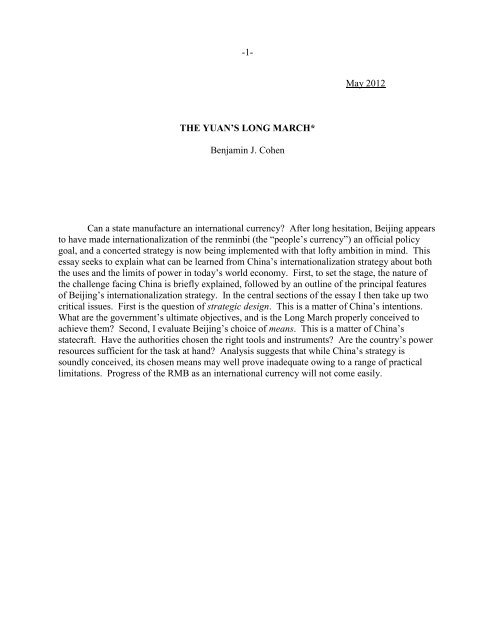

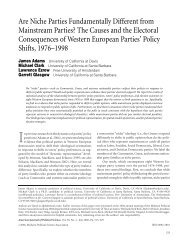
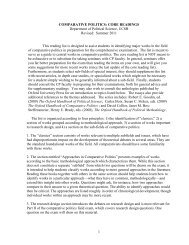
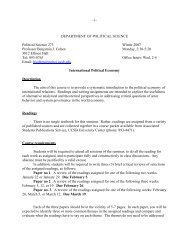

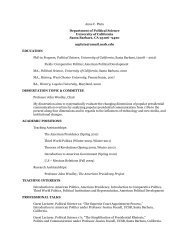
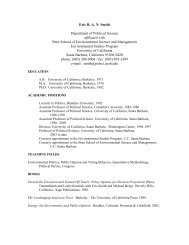
![Curriculum Vitae [abbreviated] John T. Woolley Professor of Political ...](https://img.yumpu.com/25423597/1/190x245/curriculum-vitae-abbreviated-john-t-woolley-professor-of-political-.jpg?quality=85)
